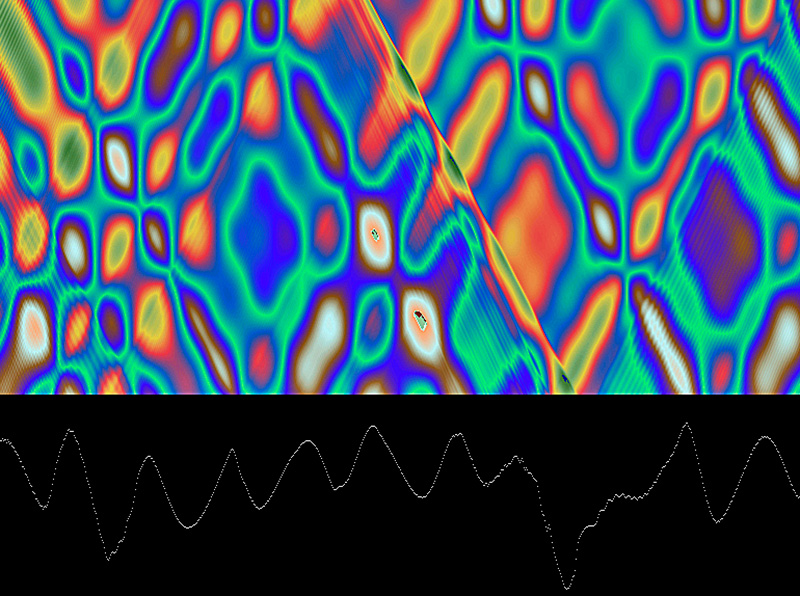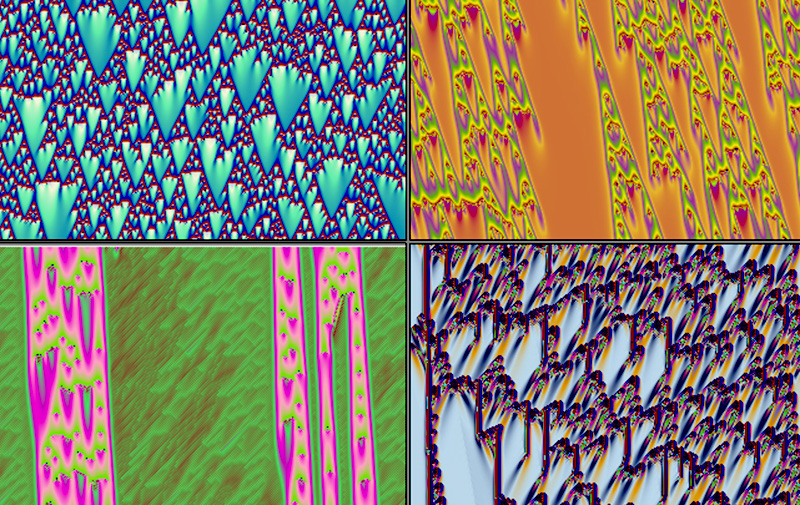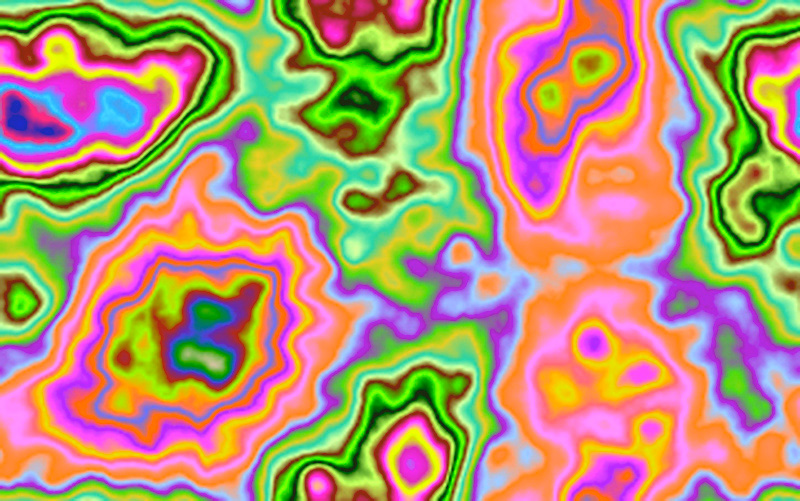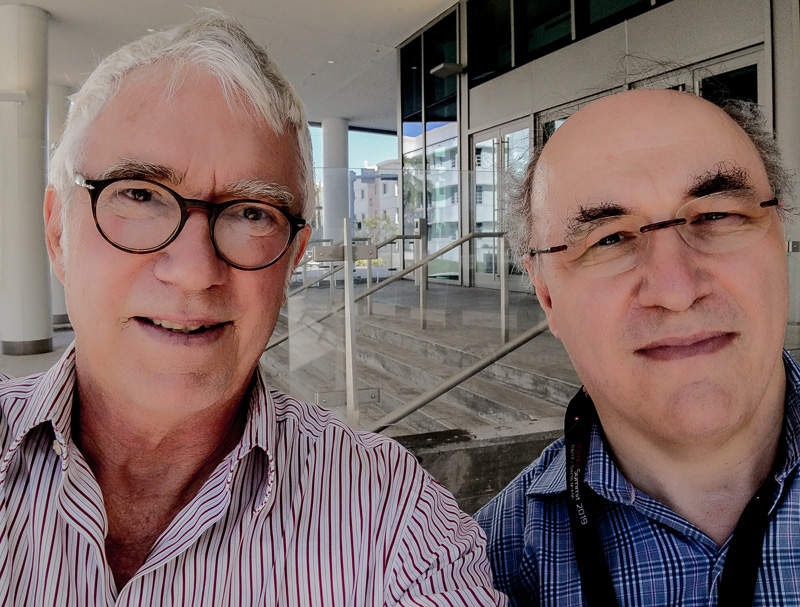My friend Stephen Wolfram has come up with a new fundamental theory of physics. He’s been meaning to do it for years. He sent me an introductory sketch or project announcement, entitled “Finally We May Have a Path to the Fundamental Theory of Physics…and It’s Beautiful”.

“Hazmat Spring” Acrylic on canvas, April, 2020, 40” x 30”. Click for a larger version of the painting.
The announcement came by email, very early in the morning of April 5, 2020. Exciting, and it was fun to think it’s true, me in the pouring rain in the dark before dawn in, yes, another plague year. I thought of Newton taking shelter on his family estate in 1665, and his insight that the force that drew the apple might reach as far as the Moon.
My guess is that some in the physics community will be a little dubious and resistant to Wolfram—–academics have never been fond of him. He’s a mix of brashness and genius, not really such an unfamiliar type in the histories of mathematics and science. But it puts some people off.
I’ve always enjoyed Wolfram. I first met him in 1985 when I visited him at the Princeton Institute for Advanced Study in order to write a popular article about his new work on cellular automata or CAs.

Already in 1985, Wolfram had figured out the two basic principles that underlie his later tome A New Kind of Science. (You can browse Wolfram’s book online.) The two principles:
(Principle of Computational Equivalence.) All interesting natural processes are universally computing, and all are fundamentally equivalent. (A waving leaf is as intelligent as a human. A cloud is as smart as a pig.)
(Principle of Computational Irreducibility.) All interesting natural processes are computationally irreducible, that is, there are no shortcut methods to predict what they’re going to do. (Weather prediction is never going to work. And you’ll never learn to predict your moods.)

I am very much a disciple of Wolfram’s, indeed I wrote my own tome about his ideas: The Lifebox, the Seashell, and the Soul. You browse my book online too. Stephen and I are out to spread the word.

[A 1D wave as a CA. The cellular automata images in this post are made with my CAPOW software, available for Windows on GitHub.]
All along Wolfram thought that small, iterated computations could be a good model for physical phenomena. Early on I asked him what engineers thought of his method of modeling turbulence with CAs. His comeback: “Some say it’s wrong, and some say it’s trivial. If you can get people to say both those things, you’re in quite good shape.”
So what’s in his new theory for the foundations of physics? It starts with the idea that a simple set of graph-rewriting rules can be started out on some minimal starting pattern like two dots connected by a line, and then, if the rules in the rule set are recursively applied and reapplied to successive outputs, the process will generate interestingly complex and gnarly patterns. Like watching a cellular automaton evolve. And this might be how our universe arises. So far this is a standard Wolfram move.

[Sculpture of Pythagoras at the Rosicrucian World Headquarters in my home town of San Jose. I’m not at all involved with the group, but I enjoy the gardens there and the Egyptian style decor. One of the few sights to see in old San Jo’.]
But then, being Wolfram, he kicks it up a level and another level and another. He considers the option of running all the rules in his rule set at each step, and seeing what you get. A multiway rule, as it were. And then he suggests using all possible sets of rules and seeing what you get.

You’d expect a tangled, mess, but somehow there emerges a single over-arching “world.” In this world, each viewer “sees” through the filter of their own particular update rules. And Wolfram calls this shared world “rulial space”, the space of all possible world rules.

The scope of Wolfram’s ambition is boundless. And that’s a good thing. He he knows he can’t finish the work on his own. So he’s started the Wolfram Physics Project, and he invites one and all to study the material—and to participate. There’s an outside chance you, just as you are, might cook up some simple set of rules that…generate the entire universe! Go for it, dude. I’ve been playing slot-machine with new CA rules for thirty-five years.

“Happy Egg” Acrylic on canvas, April, 2020, 40” x 30”. Click for a larger version of the painting. More info on Rudy’s Paintings page.
Here’s two tantalizing quotes from the end part of Wolfram’s project announcement.
(1) I’ve always assumed that any entity that exists in our universe must at least “experience the same physics as us”. But now I realize that this isn’t true. There’s actually an almost infinite diversity of different ways to describe and experience our universe, or in effect an almost infinite diversity of different “planes of existence” for entities in the universe—corresponding to different possible reference frames in rulial space, all ultimately connected by universal computation and rule-space relativity.

(2) But there is something perhaps more bizarre that is possible. While we view our universe—and reality—through our particular type of description language, there are endless other possible description languages which can lead to descriptions of reality that will seem coherent (and even in some appropriate definition “meaningful”) within themselves, but which will seem to us to correspond to utterly incoherent and meaningless aspects of our universe.

[Spherical painting by Dick Termes of Termespheres fame.]
This line of speculation segues into my ongoing SF obsession with describing thoughts of stars, wasps, atoms, stones, etc. I worked on this in my novels Postsingular and Hylozoic.

[A 2D continuous-valued reactino-diffusion CA made with CAPOW.]
But there’s hints of wilder, newer, even more, unheard-of ideas in Wolfram’s words. And I’m going to be pondering these inchoate notions over in the coming weeks and months and years. I like the notion of beings who see some things as coherent and meaningful—even though we see them as incoherent and meaningless.
In this context, I always come back to the chaotic wobbling of a little green plant I noticed on the bank of a stream in Big Sur. I included it in my short 2008 YouTube video, “What Is Gnarl?”
The plant was being moved by the air currents, but to my eyes it was “saying something” via the persistent shape of its particular chaotic attractor. I can’t get what the plant’s gestures mean—but the plant itself knows. The fluttering leaves and branches have every right to say they’re thinking. But I don’t know what the thoughts are about. Like—“How far to the left can I sway?”
Contrariwise—to the plant, I’m as inscrutable as a cloud, as sudden as a car accident.
I like that Wolfram keeps hammering on his observation that, given that pretty much every process is a universal computation, and none of them has pride of place.
I think of that corny old line about Sinatra: “It’s Frank’s world, the rest of us just live in it.” Not true! It’s equally well the world of that humble, floppy, little plant I saw on that happy day by the creek near Pfieffer Beach.

I discussed some of these ideas with Wolfram last year at a con in Miami, and I recorded our conversation as my Podcast 106.
Here Wolfram again made the point that his Principle of Computational Equivalence says that any nontrivial natural process can emulate any other computation at all. Now consider the computations inherent in our vaunted smart brains. There may be equally rich computations inherent in the weather system, or the ecology of a forest, or the flow of a waterfall, or in the flames of a fire. So even our smartness doesn’t make us unique. Nothing about humanity is unique. And looking for extraterrestrial aliens is a quixotic endeavor. We’ve got zillions of “alien intelligences” inherent in the natural processes all around us here on Earth.

To really make this idea hit home, Wolfram he then said something like this. “Suppose that we find ways to encode human minds in software. These coded processes are like souls. And perhaps at the end of time, there will be a box with ten trillion human souls in it. Now suppose someone looks at the box from the outside. There’s really no objective difference between this box, and a box with turbulent water in it, or a box that’s simply a block of stone, with the atoms vibrating and endlessly interacting. Every time that humans have thought they were special, or at the center of things—they’ve been wrong. We thought consciousness was special, but it’s not.”

Now mix that into his new Physics…and you’ve got some great ideas for SF stories.









April 22nd, 2020 at 8:26 pm
Almost infinite? What an interesting notion!:-)
April 23rd, 2020 at 10:25 am
Wolfram’s own rule 30 is an exception to his Principle of Universal Computation. All ‘interesting’ processes are universal computers, if that’s what you’re interested in.
I’ve skimmed his paper, and as for founding physics, he’s got less than the string theorists. I suspect that, like them, he’s not even wrong. For one thing, physics is known to be nonlocal. That’s OK if computation time is not the same as cosmos time. That’s how I write my books: nonlocally in book time.
I do like how he derives both the Lorentz transformation and sum-over-histories from confluence; that is, computing the same thing two different ways yields the same answer. Basic physics from basic math; neat.
I’ve noticed that an age’s cosmology sometimes reflects its coolest technology. When clocks were new, the universe was a clockwork; some of the same physicists who built the Bomb also built the Big Bang; and now that computers are cool, the universe is turning into a computation. I call it the Law of Cosmic Coolness.
April 23rd, 2020 at 1:23 pm
Right, Emilio. Instead of “almost infinite” it might be better to say “boundless” or “inconceivably large.”
And Nathaniel, you’re making the point that Rule 30 is not in fact known to be universally computing. I write about this issue in The Lifebox, the Seashell, and Soul…you can read the section here. It goes back to Post’s Problem: “Is there a computation M such that M has an unsolvable halting problem, but M is not universal?” And the answer turns out to be yes. So we want to be careful about saying all naturally occuring computations are universal. So Wolfram waters it down a bit.
• Wolfram’s Principle of Computational Equivalence (PCE). Almost all processes that are not obviously simple can be viewed as computations of equivalent sophistication.
If you want to play it even safer, you can go for what I call the NUH.
• Natural Unsolvability Hypothesis (NUH). Most naturally occurring complex computations have unsolvable halting problems (that is, are unpredictable.)